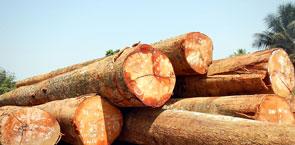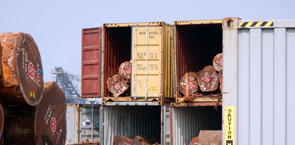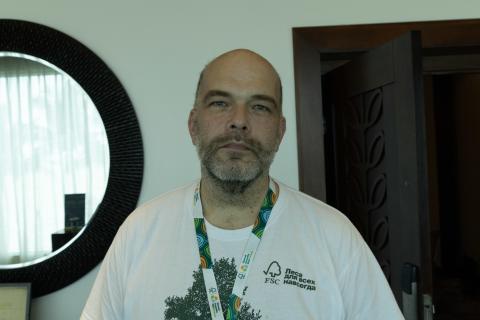Controlled Wood reinvented
The FSC Controlled Wood (CW) system is facing a major makeover that will align the FSC system further with legal frameworks such as the EUTR. It will also benefit companies sourcing CW through smarter and more streamlined procedures. Join the second consultation.
The revised FSC Controlled Wood Standard (FSC-STD-40-005) is out for the second public consultation. The standard is expected to be in force from 2015.
 FSC has redesigned the Controlled Wood concept to address weaknesses and align with the EU Timber Regulation (EUTR) and similar legislation in Australia and the US.
FSC has redesigned the Controlled Wood concept to address weaknesses and align with the EU Timber Regulation (EUTR) and similar legislation in Australia and the US.
The main purpose of the CW system remains the same: to prevent wood from unacceptable sources from entering into FSC certified products.
That said, these are probably the only elements of the CW system that are not about to undergo major change.
An ambitious move
Ambitions are high: FSC intends to maintain detailed assessments of the risk of sourcing wood from unacceptable sources across the entire globe. And as though this massive effort weren’t enough, FSC will also suggest specific control measures that companies can take to avoid sourcing of unacceptable material.
FSC recognises that this large-scale process will take time. The risk assessments are thus expected to be delivered by FSC over the next three years.
Potential beyond the FSC system
The risk assessments have the potential to be used far beyond the FSC world. FSC has taken the leadership to provide accessible data, providing much-needed information for organisations that are sourcing wood products.

EU operators are in desperate need of information on legality risk in the countries they are sourcing from, and on how to mitigate those risks. FSC will provide this information in accessible format. This will help to fill in an important information gap that appeared after the enforcement of the EUTR and before the FLEGT license system has fallen into place.
Many companies with responsible timber sourcing policies are using criteria similar to those used in the FSC CW system.
The FSC risk assessments will also be a valuable resource for them when sourcing non-certified products.
A due diligence approach
The FSC CW standard used a due diligence approach long before the term was introduced for the EUTR. The new standard is called a due diligence standard and uses a more developed approach for evaluating and mitigating risk at forest level and at supply chain level.
The basic sourcing principle starts with an evaluation of the risk given in the FSC Risk Assessment. If there is low risk, then wood from that area can be accepted. If risk exists, companies can establish the control measures that are recommended in the risk assessment. If the company can document the efficiency of control measures in mitigating the risk, the wood it can be accepted – if not, it cannot be sourced as FSC Controlled Wood.
Control measures – an intelligent approach to risk handling
Control measures play a core role in the new standard. If there is a risk of sourcing unacceptable timber, you must implement control measures to mitigate that risk. FSC’s control measures are similar to the “risk mitigation actions” in the EUTR.
This is a major difference compared to the current CW standard, which requires field audits in all cases of risk that cannot be classified as low. Experience has shown that this is an inefficient and costly way of tackling risk.
The current CW standard requires certificate holders to use a sampling method and to conduct field verification after you have received the wood.
 However, relying heavily on field sampling has some serious limitations. And if there is a risk of e.g. child labour or logging of high conservation value forest, a visit to the harvesting site after completion of the logging isn’t going to be very helpful.
However, relying heavily on field sampling has some serious limitations. And if there is a risk of e.g. child labour or logging of high conservation value forest, a visit to the harvesting site after completion of the logging isn’t going to be very helpful.
Similarly, if there is risk of illegal logging, a copy of a felling permit and a visit to the site covered by that permit make you none the wiser regarding whether the wood you received at the gate was in fact harvested at that site.
For all you know it might still have been harvested somewhere else, perhaps in contravention of applicable laws.
Control measures constitute a more intelligent approach to risk management. In the new CW framework, you must select the right measures based on the exact risk involved, and you will often need to cooperate closely with your suppliers.
The measures you need to take will often depend on the exact risk involved and where you are placed in the supply chain. A couple of examples:
- If there is a risk that the wood may come from other sites than those indicated in official documents, the mill that you source from may reduce the risk by requesting their suppliers to equip their trucks with GPS tracking devices.
- If the risk relates to social issues such as child labour or health and safety, control measures will typically consist in excluding logging companies that are known to be involved in unacceptable practices.
- The existing standard deals with risk through field auditing only. In the new standard, field audits may be required only when really needed or to verify the effectiveness of chosen control measures. E.g. you may have decided to control the risk of labour law violations by avoiding dubious logging firms. To verify the effectiveness of this control measure, you may pay a visit to active harvesting sites, double-checking that your contractor does not use under-age or illegal labour.
Simpler rules ahead
At a first glance, the new FSC CW system looks rather complex. However, this is mainly due to the transition and the fact that the key tool for companies sourcing controlled wood – the national risk assessments – is still under development.
When fully implemented, users are likely to find the CW system considerably simpler than it is now. Some key points:
- If you buy CW material from FSC Chain of Custody certificate holders or FSC CW certified forest operations, you will no longer need to be evaluated against the CW Standard. Relevant requirements will be included in the Chain of Custody Standard.
- If you are sourcing CW material from non-certified sources, you will follow the FSC-approved risk assessments. You no longer have to conduct your own risk assessment.
- If you are sourcing CW from risk areas, you can limit your efforts to focus on the real problems instead of taking a shotgun approach to risk minimisation. For example, in countries with high corruption levels, the current standard requires field verification covering all potential legal violations. The new standard will specify which particular legal risks exist in a region and recommend ways to address them. This is a much more targeted and efficient approach to tackling potential risk.
- You will need to collect less paper. The current standard requires collection and verification of specific documents regardless of the risk level, e.g. sales and transport documents showing the exact origin of the wood. Documentation may be redundant if the risk is low. And often, paper alone proves nothing. For example, a felling permit does not prove that the permit is related to the product you buy. Instead, the new CW framework requires you to evaluate the risk that the wood is mixed with unacceptable material or comes from areas other than those indicated by the supplier. You need to mitigate any risk by taking appropriate control measures. This could for example consist in a combination of a harvesting permit and GPS tracking of logs.
Smooth transition
FSC has taken a number of steps to ease the transition to the new system:
- FSC has kick-started the development of risk assessment covering the 20 top priority countries from where the bulk of controlled wood is currently sourced. FSC expects these assessments to be ready when the new standard comes into force.
- The results of risk assessments will be published at the Global Forest Registry which is being re-designed to hold the new and more detailed information. This will provide for easy access to updated risk information.
- For countries already covered by national risk assessments under the old rules, companies can continue to consider low risk areas as such until the assessments have been updated.
- Until FSC has approved a national risk assessment, companies can conduct their own interim risk assessment based on new rules which are also being consulted. This option is only available until 2017.
Provide your input
FSC invites comments from all interested stakeholders on the new proposed controlled wood system.
> Learn more and join the consultation before 30 June 2014
Photos: Christian Sloth/NEPCon



